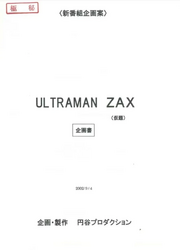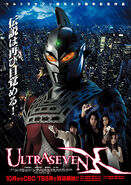Ultraseven X is the 20th entry in the Tsuburaya Productions' Ultraman Series. It is a revival of the 1967 series Ultraseven, and is the first Ultraman series to be exclusively for an adult audience and in wide screen high-definition format. The show first aired on October 5, 2007 at 2:15am on CBC and 2:25am on TBS.
On May 11, 2017, TOKU announced that the series will air in the United States on its channel with English subtitles beginning June 5 until June 12, 2017.[1]
The series can be watched on Shout TV, Tubi, Prime Video, and Vudu.
Production

Since its debut in 1967, the character Ultraseven has consistently been one of the most popular heroes in the Ultraman series. This popularity stems not only from the character itself but also from the series' ability to deliver high-quality content, weaving intricate and essential stories. This was especially evident in the Heisei Ultraseven series that ran from 1994 to 2002. Subsequent series have shown the influence of Ultraseven in various characters, settings, and designs.[3]
The series has demonstrated its strong influence through multiple reruns and impressive merchandise sales, proving to TBS that the Ultraman series still holds significant market appeal.
The idea of using Ultraseven as a springboard for change is similar to the subversive character settings seen in the 2004 TV series Ultra Q: Dark Fantasy, produced in collaboration with Tsuburaya Eizo. In the summer of 2006, a new project titled Ultra Minds was proposed by Yukiko Omote, the producer of Ultra Q Dark Fantasy. This project aimed to pitch to Chubu-Nippon Broadcasting, which was then airing Ultraman Mebius.[3]
To drive the project forward, Yukiko Omote reached out to Takeshi Yagi, as his schedule would open up after filming some episodes of Ultraman Mebius. Simultaneously, she also requested the assistance of producer Hiroyasu Shibuya in planning. Yukiko Omote had met Yagi during the production of Ultra Q Dark Fantasy and invited Yuji Kobayashi to participate in the project's careful planning. In early 2007, the project underwent a realignment, planning to capitalize on Ultraseven's 40th anniversary by developing a new late-night program. In this new plan, Takeshi Yagi not only served as the director but also took charge of the series composition.[4]

Yagi drew inspiration from two visual impressions: a man sinking into water and a woman turning back while standing by a window. Together with Kobayashi, they explored various elements and seamlessly integrated these striking visual impressions into the series. One of the reference materials was a proposal called ULTRAMAN ZAX, which Yagi pitched after the conclusion of Ultraman Cosmos in 2002 as part of Tsuburaya Productions' new series. This proposal envisioned a world where various aliens secretly lurk on Earth, aiming to unfold the story with stylized performances. However, since the TV series ultimately chose Ultraman Nexus at the time, the proposal was never realized.[4]
As a result, while inheriting the stylized elements of ULTRAMAN ZAX, Yagi and Kobayashi finalized the plan for Ultraseven X in approximately three months. It has become a consensus that this series is different from the past Ultraseven.[4]
Taking cues from past Heisei Ultraman series and elements from overseas dramas like 24 and Battlestar Galactica, despite differences in production budgets, there was a strong emphasis on the storyline as the key to attracting audiences.[6] This attitude also influenced the participating writers, resulting in stories that unfold in a strong dystopia tone with ironic imagery of modern society. These narratives encapsulate a sense of pervasive unease with no escape. However, the conclusion of the series depicts liberation from malevolence, bringing about a satisfying resolution. Despite the commitment to a serious science fiction direction, the eventual unfolding reflects the television series' dignity, positioning hope as the endpoint, which is deemed the mission of the Ultraman series.[4][7]
As this series is a late-night drama with relatively minimal emphasis on merchandising beyond visual software, it couldn't raise substantial production costs. To address this, visual expressions departed from the traditional approach of miniature models. During filming, all the scenes of giant battles were shot against blue or green screens and processed digitally with real-life settings.[4]
Synopsis
The series took place in a world where all forms of war and terrorism had long ended, bringing forth to a dystopian future. An amnesiac man named Jin awakened and was entrusted with missions given by DEUS to fight against aliens that had slipped into the human society, joining forces with agents K and S. During that moment, he was given a pair of glasses by Elea Saeki to transform into the red giant. While fighting to preserve the safety of the city, Jin becomes closer to discover his memories.
Characters
DEUS
Others
Ultras
Kaiju
- Galkimes
- Unidentified alien criminal
- Alien Markind
- Peginera
- Alien Vo-Da
- Alien Chamuda
- Soul of Light
- Alien Vairo
- Vadoryudo
- Hupnath
- Jyuujin
- Saku
- Grakyess
- Mecha Grakyess
Cast
- Jin : Eriku Yoza
- Elea : Saki Kagami
- K : Tomohito Wakizaki
- S : Anri Ban
- Government Broadcast Newscasters :
- Kenichi Miyamoto
- Yoko Azami
Guest Actors
- Leader of Alien Group : Akira Ohtani
- Lady Executive of Alien Group : MiWa
- Rulers :
- Masahiro Noguchi
- Seiki Chiba
- Michiko Nakayama
- Eriko : Tomomi Miyashita
- R : Toshiyuki Watarai
- Tamaru/Alien Markind : Takayasu Komiya
- Tazaki : Edo Yamaguchi
- Yamane : Tsutomu Okabe
- Slender Man/Alien Chamuda : Kenji Yabe
- Takao : Mitsuru Karahashi
- Alisa : Nao Oikawa
- Nataru : Saaya Ishikawa
- D : Ryohei Odai
- Street Singer : Hiroko Ebioka
- Kyosuke Agata/Hupnath : Yuuki Kuroda
- Asami Agata : Yukie Kawamura
- Sameo : Yuki Ito
- Ogata/Saku : Hassei Takano
- Mahiru : Kaori Nakamura
- Nozomu/Jyuujin : Hiro Ogasawara
- Professor Shikishima : Masami Horiuchi
- Saki : Shion Nakamaru
- Haibara : Ryuki Kitaoka
- Anne Yuri : Yuriko Hishimi
- Dan Moroboshi : Kohji Moritsugu
Voice Actors
- DEUS Commander : Yosuke Natsuki
- Soul of Light : Asami Imai
Suit Actors
- Ultraseven X: Hiromi Shinjo [8]
- Junya Soma
- Rou Nishimura
- Alien Vo-Da: Hideyoshi Iwata
- Daisuke Fukuda
Stunts
- Makoto Arakawa
- Sojiro Komatsu
- Taro Murai
- Junya Iwamoto
- Yoshihiro Sakate
- Masaki Onishi
- Kazunori Yajima
- Yu Sato
- Hideki Sugiguchi
- Junya Matsukami
- Masashi Nitta
- Emiko Saito
- Koichi Funayama
- Takeshi Daihisa
- Rumi Tsuchiya
- Koji Kawamoto
- Fumihito Minamitsuji
- Hiromasa Ito
Staff
- Directors: Takeshi Yagi (main director),[7] Kenji Suzuki, Kengo Kaji, Kazuya Konaka
- Series compositor: Takeshi Yagi
- Screenwriters: Yuji Kobayashi (head writer),[9][10] Ai Ota, Takuro Fukuda, Jiro Kaneko, Sotaro Hayashi, Keiichi Hasegawa
- Supervisor and executive producer: Kazuo Tsuburaya
- Production supervisor: Shinichi Ooka
- Music producer: Shizuka Tamagawa
Music
- Ending Theme
- Another day comes
- Lyrics: K (Kei Goto)
- Composition and Arrangement: Pay money To my Pain
- Artist: Pay money To my Pain
Home Media
The series was released on DVD as 6 volumes, published by VAP. There are standard and premium editions of the DVDs, with each premium edition coming with an accessory (an Ultra Eye toy, an Eye Slugger toy, a polystone relief, an Ultra Gun toy, a Video-Ceiver toy, and an Ultraseven X figure).
A Blu-ray of the series in 1080i with English subtitles was released on April 5, 2022 by Mill Creek.[11]
Gallery
Trivia
- This is currently the last Ultraman Series entry to be aired on Tokyo Broadcasting System (TBS).
External Links
References
- ↑ TOKU to Air Ultraseven X Live-Action Series, Queen's Blade: Wandering Warrior Anime
- ↑ https://www.monomagazine.com/57187
- ↑ 3.0 3.1 Ultra Tokusatsu PERFECT MOOK vol. 39: Ultraseven 1994/1998/1999/2002 (Heisei Ultraseven) / Ultraseven X, pg 24
- ↑ 4.0 4.1 4.2 4.3 4.4 Ultra Tokusatsu PERFECT MOOK vol. 39: Ultraseven 1994/1998/1999/2002 (Heisei Ultraseven) / Ultraseven X, pg 25
- ↑ https://k.mandarake.co.jp/auction/item/itemInfoJa.html?index=500543
- ↑ https://www.monomagazine.com/56729
- ↑ 7.0 7.1 https://www.monomagazine.com/65598
- ↑ Ultra Tokusatsu PERFECT MOOK vol. 39: Ultraseven 1994/1998/1999/2002 (Heisei Ultraseven) / Ultraseven X, pg 26
- ↑ https://www.rittor-music.co.jp/product/detail/3123317404/
- ↑ https://x.com/kobayuji/status/1624229863547887629
- ↑ https://twitter.com/MillCreekEnt/status/1508552260862849026











